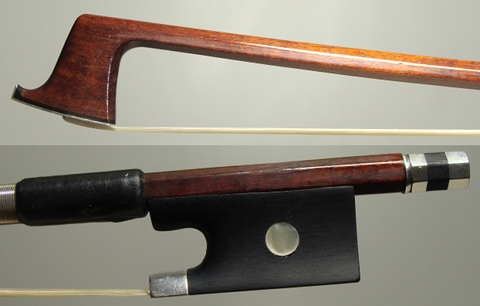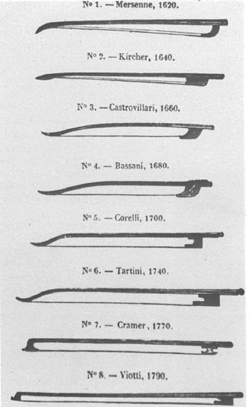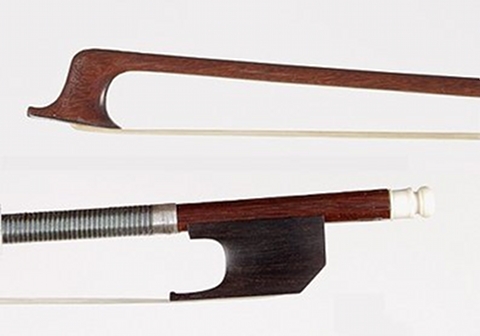CRAMER VERSUS CRAMER; OR RIGHTLY THE EVOLUTIONARY PROCESS part I
What you see below is the final result of the work, made at the end of the 17th, and the beginning of the 18th century by illuminated craftsmen, in particular Francois Xavier Tourte, on developing and defining the parameters of style and mechanism in the modern bow. Why did they do it? What need was there to find a new architectural structure, so different from the baroque bows.

Viola Bow by Francois Xavier Tourte 1815
The motives that induced composers, musicians and craftsmen to develop bows and violins as we know them today are strictly technical.
The first bows had the “Pike head”, they were shorter than the ones we know today, and without curve. The short length made it very manageable and suited for quick passages, but caused problems of long notes and related phrases.
The reason to why the baroque bows were so short, particularly the first ones, is found in the material used at the time. In the beginning of the 16th century, the European wood was still used quite a lot to make the bows. The beech had a good elasticity but was weak, therefore the craftsman had to make the structure of the bow more rigid, to increase the resistance of the string. But even with a low head and a straight stick, the result was far from optimal.
After years of research to find a suitable material, thanks to the expansion of Europe, the craftsmen got their hands on the snakewood. At the time, this material seemed to be a definitive turning point in bow making. The wood was so much more dense and compact than any other European type of wood, and furthermore it had a good specific resistance.
The heads began to get higher and the length of the bows increased without compromising the capacity. This gave new expressive possibilities to musicians in playing and composers in writing. The violin was way ahead in its evolution, actually almost at its finished stage, as we are speaking of the second half of the 17th century. The arching and the scoop were now lower, and the body of the instruments were now wider than in the previous century. The snakewood did improve he performance of bows, but the elasticity was not enough compared to the enormous tension in the new type of instruments. The snakewood, even if dense and beautiful, isn't tens in the fibre to counter the new instruments,and the result was lack in volume and definition.

They had gone a long way, but the problem was far from resolved.
The reason why composers and instrumentalists began to collaborate with violin and bow makers, was because of the problem, of the definition and the balance in the sound level. The wind instruments of the baroque period, the brass in particularly, had an enormous volume in sound, whereas the bows had very little. The brass makers committed themselves to add as many twists as possible, to tone down the power and the violin makers did their modifications as well. The bow makers were the latecomers, who had improved the performance, just not enough.
The Cramer model

Cramer Bow Model 1769
Here we are, at the turning point: the “Cramer” model. This particular model was developed to soften up the structure, and is to be considered the first modern bow, in all of its aspects.
When the craftsmen came to know the pernambuco; a material which was much stronger and elastic than any other material ever seen until this moment; they had to rethink the structure of the bow, so that it would be suitable to the musicians.
At the time, the craftsmen made bows with a high frog, a very low head (lance shape), and practically without curve. This mechanic model, without curve tended to have a rigid structure, which was fine when made of snakewood; dense but not particularly strong, whereas absolutely unusable when this model was made in pernambuco.
Now how do you obtain softness in a bow, made of an energetic wood like the pernambuco?
Simple: you make the head higher and add curve to the structure.
If the bow has a convex curve, like the primitive bows, the structure will be very rigid; if it is straight, like the baroque bows, the structure will be more flexible - though not enough; if the bow has concave curve, like the modern ones, the structure will be very soft.
The craftsmen understood the potential and the peculiarity of this wood. So much that they excluded all the work Francois Xavier Tourte had done on the frog, which is quite a bit, but has little influence on the function of the spring. The Cramer model is therefore the modern bow.
Just before ending, I will pose you to a question, which serves as an appetiser to the next post:
What if the modern bow, which we have identified for its mechanic characteristics in the Cramer model, has been developed to take advantage of the potential of the new wood just discovered; the pernambuco. How is it then possible that the first time Nicolas Leonard Tourte and his brother saw one, in 1769, brought by a known German violinist , passing Paris from Germany going to England, had the name Wilhelm Cramer?
To be continued.....
So long,
Paolo
|